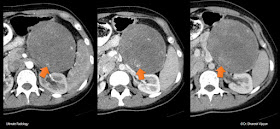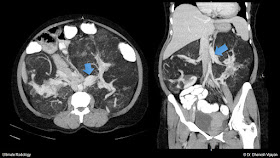Patients with abdominal pain often undergoes CT evaluation for further assessment after a baseline USG. Diagnosing aortic dissection is easy in post contrast CT (Angiogram) images, but when the patient comes for CT Abdomen, reasonable observation and high degree of suspicion is needed, to proceed with CT Chest and Abdomen Angiogram (rather than abdomen alone), otherwise we would end up taking multiphase images of abdomen alone. The therapeutic decision in dissection depend upon the detecting the involvement of preductal aorta (Stanford A), which requires emergency surgical management. Thus if we fail to detect / suspect dissection in plain study, we have to take repeat angiogram of the thoracic aorta later.
The following is a case of a 40yr old female patient who presented with abdominal pain radiating to back. USG did show slightly prominent aorta for age, which is actually a good pickup, since there was no other abnormality in abdomen.
CT Abdomen was requested for further evaluation of the abdominal pain. In the plain CT sections, the aorta was seen dilated, with proximal abdominal aorta measuring up to ~3.5cm in outer diameter. Highest section of the scan did show the dilated distal descending thoracic aorta with hyperdense peripheral crescent, indicating acute intramural hematoma (/thrombosed false lumen of dissection), which necessitates the scan to be taken from arch vessels to iliac arteries, to assess the involvement of ascending aorta, arch and to look for the inferior extent.
 |
| Dilated proximal abdominal aorta, raising the suspicion of dissection in a 40yr old female patient. |
 |
| Hyperdense crescent indicating acute intramural hematoma. |
Above image shows the proximal end of the intramural hematoma, beginning just distal to the left subclavian artery origin, making it a Stanford type B dissection. Ascending aorta and arch branches were not affected (not shown).
The hyperdense hematoma can be seen slightly rotating / whirling in an anticlockwise fashion, to come towards the left lateral aspect of aorta (see below), from the posteromedial aspect.
The dissection flap was only visualized from the D11 vertebral level.
The above image showing relationship of the true lumen (green arrow) and false lumen (orange arrow). As going distally the false lumen is seen enlarging in size.
3D-VRT images showing the dissection flap (yellow arrows).
It's important to determine the origins of branch vessels before endograft or stent placement to avoid end organ ischemia.
Axial sections showing the origins of major abdominal aortic branches, with true lumen on right and false lumen on left side. Celiac trunk, left renal artery and IMA are seen arising from the false lumen.
Dissection is the spontaneous longitudinal separation of intimal and adventitial layers because of blood traversing and splitting through the media. The inciting factor is due to an intimal tear, which allows the blood to enter into the media. The additional lumen thus formed within the media is called as the false lumen.
Aortic dissection is divided into two types according to the Stanford classification. If ascending aorta is involved then its termed type A and if it involves aorta distal to the left subclavian artery alone then its termed type B dissection.
The high attenuation within the aortic wall is either due to acute intramural hematoma or due to hyperdense false lumen.
Sometimes within the hyperdense false lumen, residual flow can be seen (as shown below).
 |
| Residual flow channel in false lumen (Orange arrow). |
References:
1. AJR 2001 July article.
2. RG March-April 2010 article.
















































